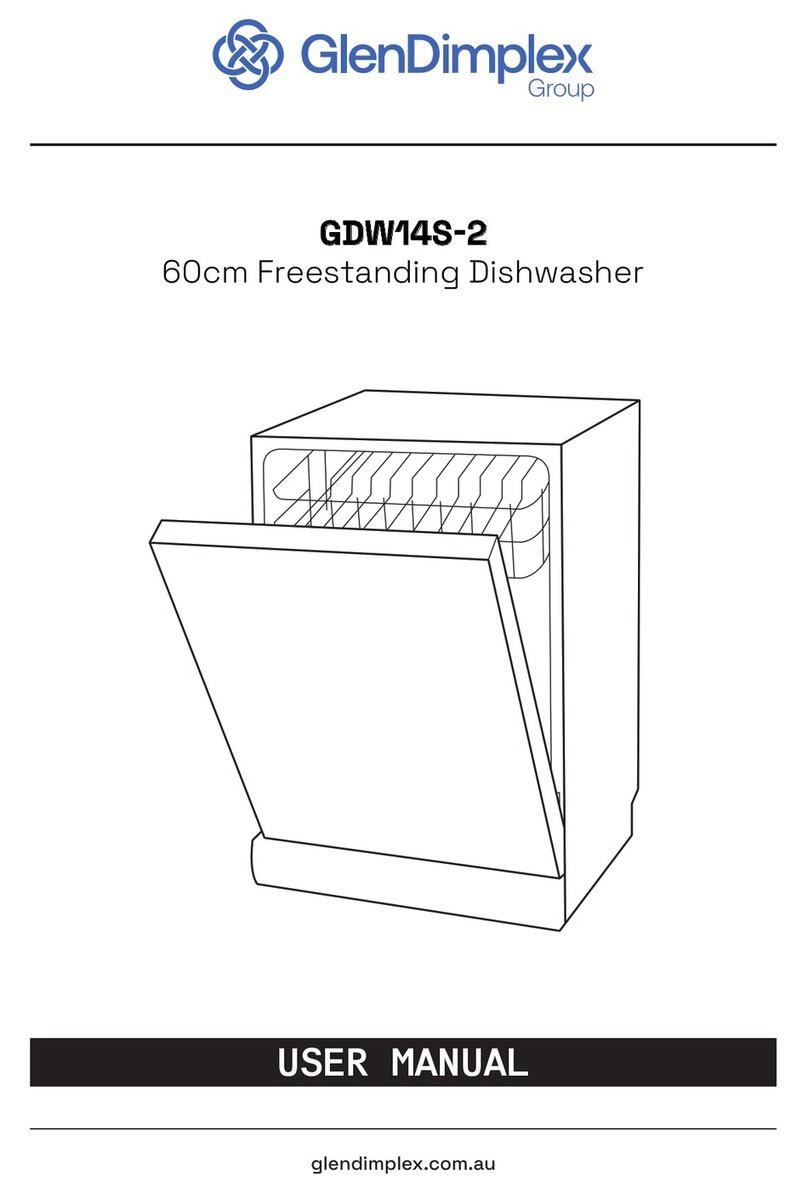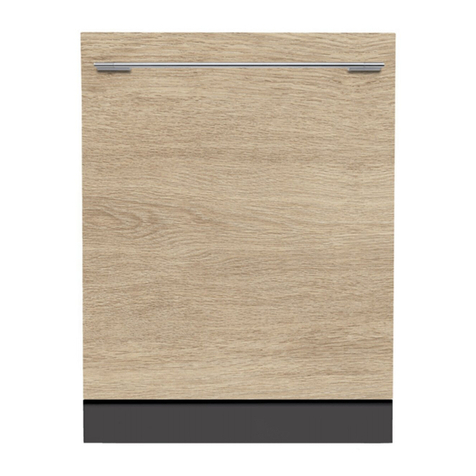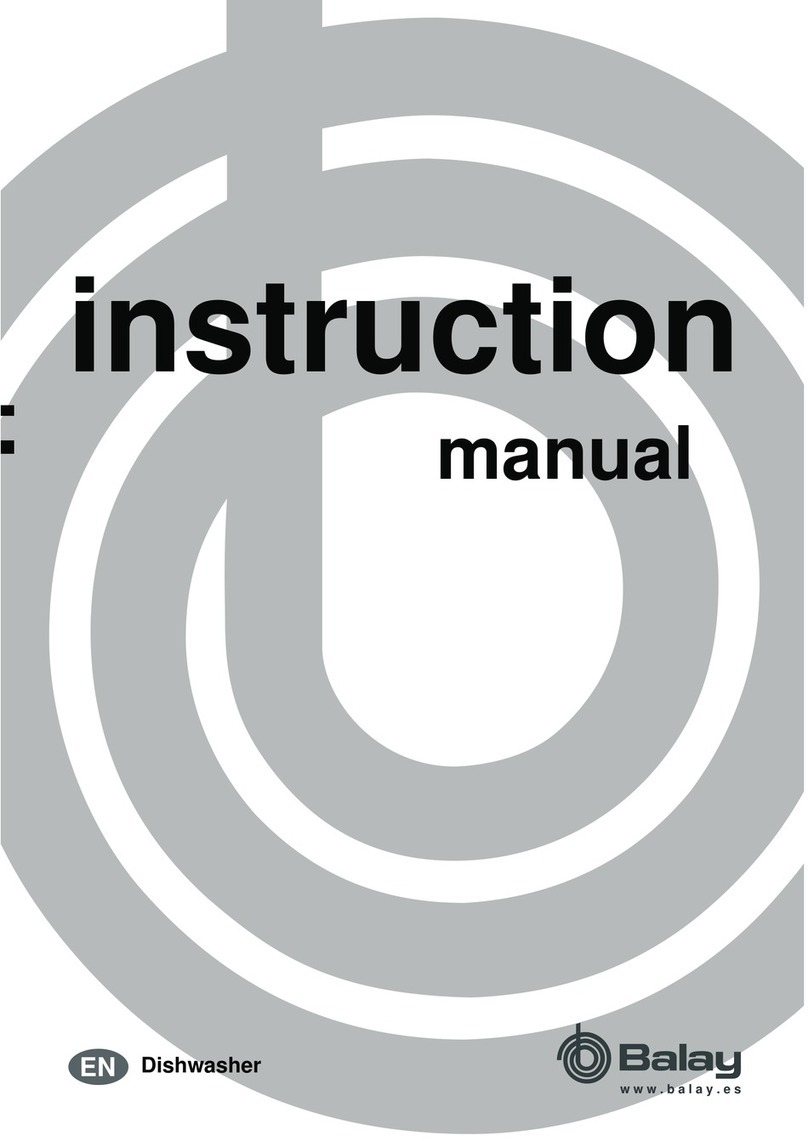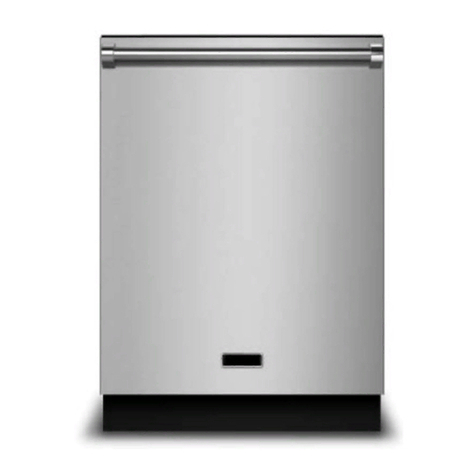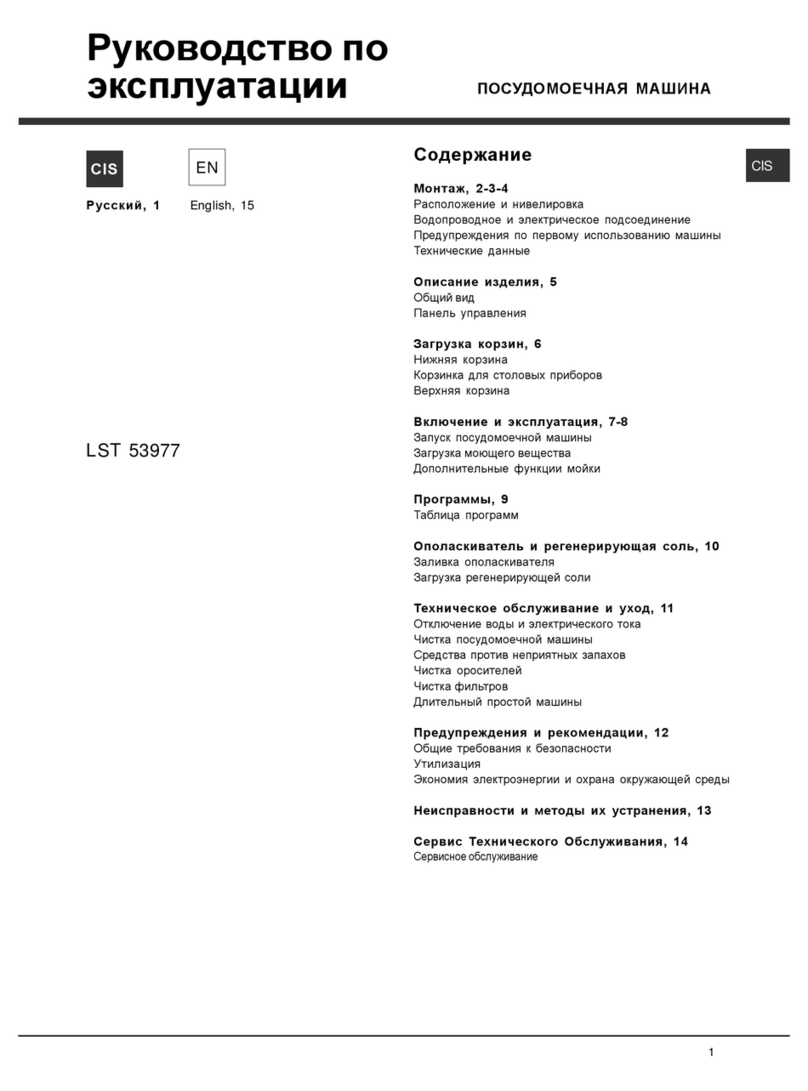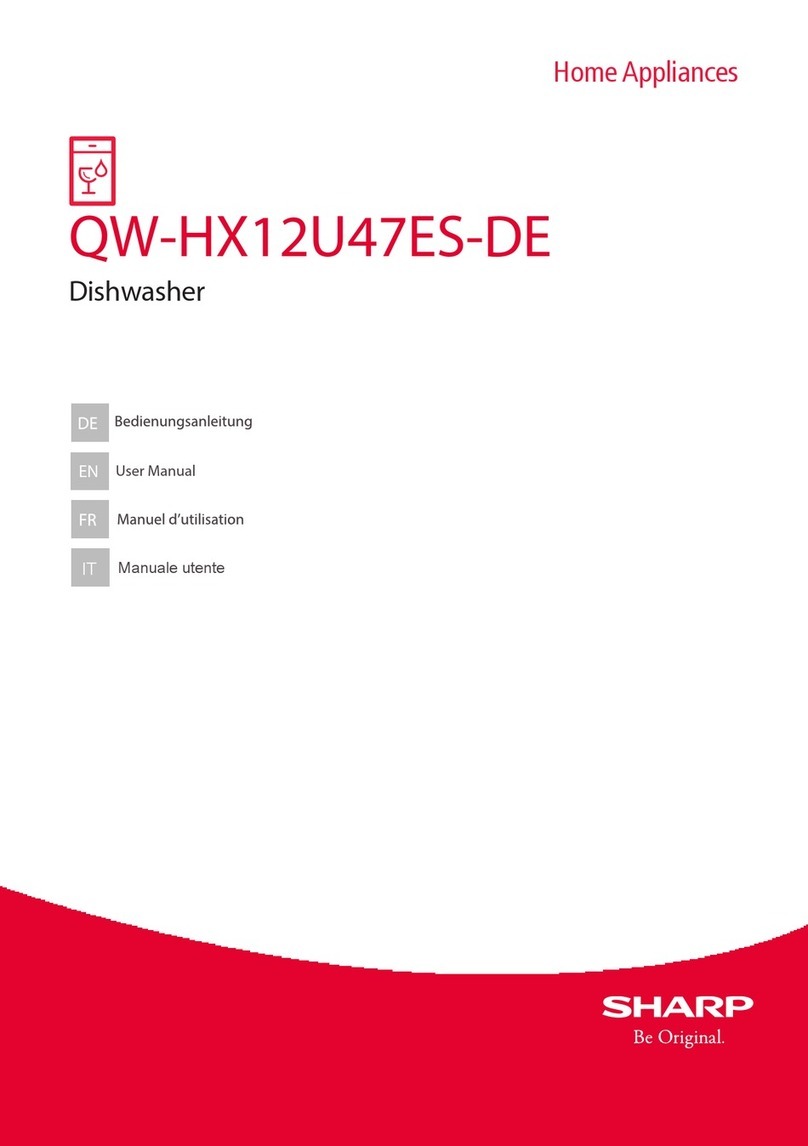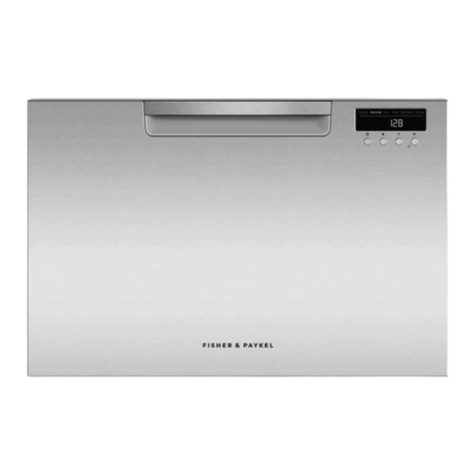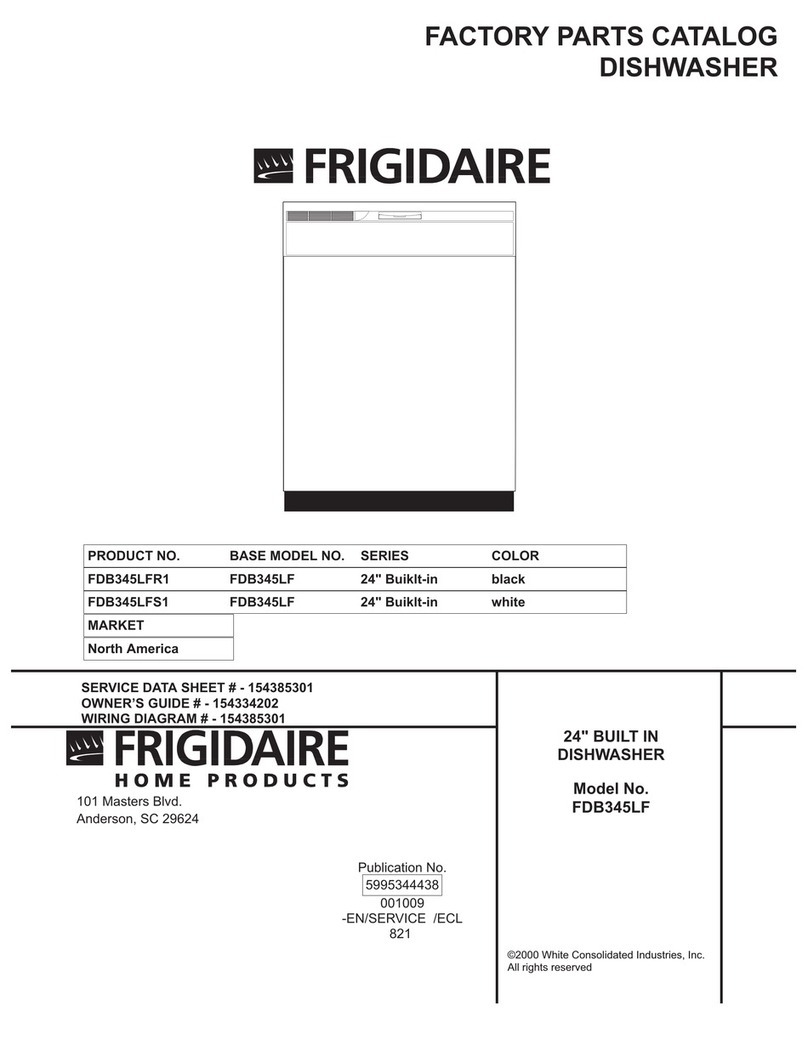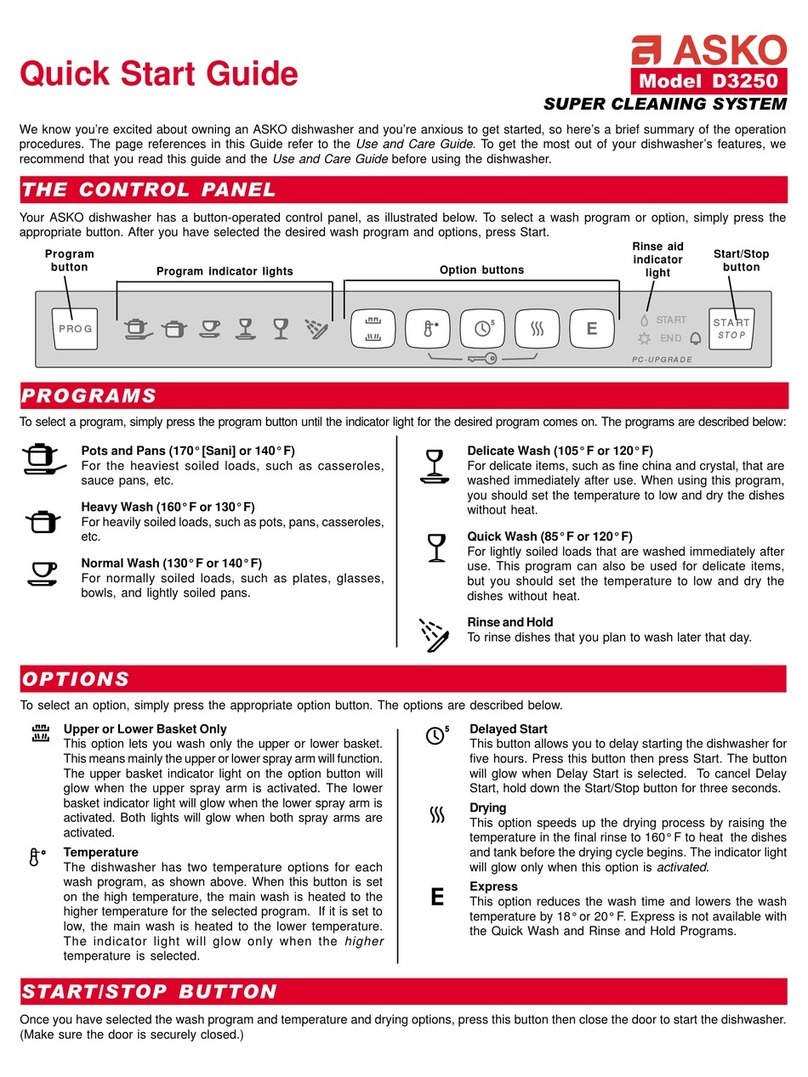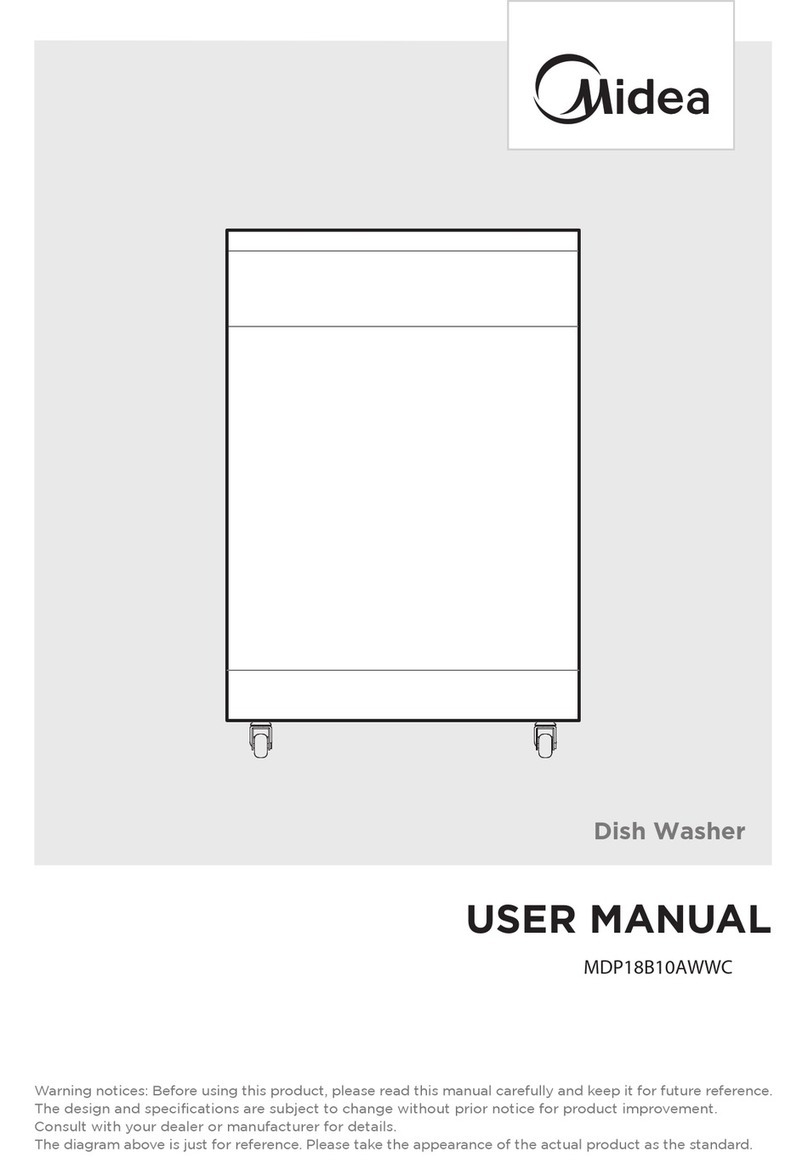Glen Dimplex GDW45S-2 User manual

USER MANUAL
Please read the User Manual carefully before use
GDW45S-2
45CM FREESTANDING DISHWASHER
www.glendimplex.com.au

PG 2 PG 3
1) Safety Information 4
2) Disposal 5
3) Operation Instructions 6
Control Panel 6
Dishwasher Features 6
4) Prior to using for the first time 7
Fill the Rinse Aid Dispenser 7
Function of Detergent 8
5) Loading the Dishwasher Baskets 11
6) Starting a washing programme 15
Wash Cycle Table 12
Turning on the Appliance 12
Change the Programme 13
Forget to Add Dish 13
7) Maintenance and cleaning 17
8) Installation 18
Positioning and leveling 19
Connecting the water and electricity supplies 20
9) Troubleshooting Tips 22
Error codes 21
Before calling for service 22
Technical information 23
READ THIS MANUAL
Dear Customer,
Please read this User Information carefully and keep it to
refer to at a later date. Pass it on to any subsequent owner
of the appliance. This manual contains sections of Safety
Instructions, Operating Instructions, Installation Instructions
and Troubleshooting Tips, etc. Carefully read it before using the
dishwasher will help you to use and maintain the dishwasher
properly.
Before Calling for Service
The section on Troubleshooting Tips will help you to solve some
common problems by yourself and not need to ask for the help of
professional technicians.
Note:
The manufacturer, following a policy of constant development
and up-dating of the product, may make modifications without
giving prior notice.
CONTENTS

PG 4 PG 5
WARNING !
When using your dishwasher, follow the basic precautions including the following:
WARNING! HYDROGEN GAS IS EXPLOSIVE
Under certain conditions, Hydrogen gas may be produced in a hot-water system that has not been used for two weeks or more.
HYDROGEN GAS IS EXPLOSIVE. If the hot-water system has not been used for such a period, before using the dishwasher turn on all
hot-water faucets and let the water flow from each for several minutes. This will release some accumulated hydrogen gas. As the gas
is flammable, do not smoke or use an open flame this time.
WARNING! PROPER USE
• Do not abuse, sit on, or stand on the door or dish basket of the dishwasher.
• Do not touch the heating element during or immediately after using.
• Do not operate your dishwasher unless all enclosure panels are properly in place. Open the door very carefully if the dishwasher
is operating. There is a risk of water squirting out.
• Do not place any heavy objects or stand on the door when it is open. The appliance could tip forward.
When loading items to be washed:
- Locate sharp items so that they are not likely to damage the door seal;
- Load sharp knives with the handles up to reduce the risk of cut-type injuries;
- Warning: Knives and other utensils with sharp points must be loaded in the basket with their points down or placed in a
horizontal position.
• When using your dishwasher, you should prevent plastic items from contacting with heating element.
• Check that the detergent receptacle is empty after completion of the wash cycle.
• Do not wash plastic items unless they are marked dishwasher safe or the equivalent. For plastic items not so marked, check the
manufacturer's recommendations.
• Use only detergent and rinse additives designed for an automatic dishwasher. Never use soap, laundry detergent, or hand
washing detergent in your dishwasher.
• Other means for disconnection from the supply must be incorporated in the fixed wiring with at least 3mm contact separation
in all poles.
• Keep children away from detergent and rinse aid, keep children away from the open door of the dishwasher , there could still
be some detergent left inside.
• These instructions shall also be got form the manufacturer or responsible Vendor.
• To protect against the risk of electrical shock, do not immerse the unit, cord or plug in water or other liquid.
• This appliance is not intended for use by persons (including children) with reduced physical, sensory or mental capabilities, or
lack of experience and knowledge, unless they have been given supervision or instruction concerning use of the appliance by
a person responsible for their safety. Young children should be supervised to ensure that they do not play with the appliance.
• Dishwasher detergents are strongly alkaline. They can be extremely dangerous if swallowed.
• Avoid contact with skin and eyes, and keep children away from the dishwasher when the door is open.
• The door should not be left in the open position since this could present a tripping hazard.
• If the supply cord is damaged, it must be replaced by the manufacturer or its service agent or a similarly qualified person in
order to avoid a hazard.
• Please dispose of packing materials properly.
• During installation, the power supply must not be excessively or dangerously bent or flattened.
• Do not tamper with controls.
• The appliance is to be connected to the water mains using new hose sets, and the old hose-sets should not be reused.
• Make sure that the carpet does not obstruct the openings at the bottom base.
• Use the dishwasher only for its intended function.
• The dishwasher is intended for indoor use only.
• The dishwasher is not designed for commercial use. It is intended for use in domestic households and in similar working and
residential environments.
READ AND FOLLOW THIS SAFETY INFORMATION CAREFULLY SAVE THESE INSTRUCTIONS
1. SAFETY INFORMATION
2. DISPOSAL
Dispose of the dishwasher packaging material correctly. All packaging
materials can be recycled.
Plastic parts are marked with the standard international abbreviations:
(e.g. PS for polystyrene, padding material)
This appliance is identified according to the European guideline
2002/96/EC on waste electrical and electronic equipment -WEEE. The
guideline specifies the framework for an EU-wide valid return and re-
use of old appliances.
Packaging material could be dangerous for children!
For disposing of package and the appliance please go to a recycling centre. Cut off the power supply cable and make the door
closing device unusable. Cardboard packaging is manufactured from recycled paper and should be disposed in the waste paper
collection for recycling. By ensuring this product is disposed of correctly, you will help prevent potential negative consequences
for the environment and human health, which could otherwise be caused by inappropriate waste handling of this product. For
more detailed information about recycling of this product, please contact your local city office and your household waste disposal
service.
To get the best performance from your dishwasher, read all
operating instructions before using it for the first time.
WARNING

PG 6 PG 7
3. OPERATION INSTRUCTIONS 4. PRIOR TO USING FOR FIRST TIME
CONTROL PANEL
DISHWASHER FEATURES
1. Power switch: To turn on/off the power supply.
2. Delay button: the DELAY START will allow you to delay the start time of any cycle automatically up to 24 hours.
3. Program button: Press the button to scroll through the wash cycles. The corresponding programme light will be ON to indicate
which WASH CYCLE has been slected.
4. 3 in 1 button: Press this button to selector cancel the “3 in 1” function.
5. Dry+button: Press this button to select or cancel the Dry+ function.
6. Start/ pause button: The appliance will start or pause the selected washing cycle.
7. Child lock button: Press the two buttons for 3 seconds, the appliance will lock and no buttons can be used.
8. Program indicator light: When you select a washing programme, the corresponding light will display.
9. Dry+ indicator: The indicator will be available when the Dry+ button is selected. An increased temperature will improve the
drying process during the final rinse stage . The function can be used when you select Intensive, Heavy, Normal.
10. Rinse aid refill indicator: The indicator lights up when dispenserneeds to be refilled.
11. Child lock indicator: The indicator lights up when you press the Child lock bttons for 3 seconds, child lock will be active after flashing 6 times.
12. 3 in 1 indicator: The indicator lights up when the button is selected.
13. Washing light: When the dishwasher is washing.
14. Drying light: When the dishwasher is drying.
15. Digital display: Displays the running time remaining. Malfunction codes and delay time.
12
3
78
11
6
4
9
12
13
14
15
3
3
i
i
n
n
1
1
5
10
D
D
r
r
y
y
+
+
Front View
1. Upper Basket
2. Spray Arms
3. Lower Basket
4. Filters
5. Detergent Dispenser
6. Rinse Aid Dispenser
7. Cutlery basket
Before using your dishwasher for the first time:
A. Fill the rinse aid dispenser
B. Function of detergent
A. FILL THE RINSE AID DISPENSER
Function of Rinse Aid
Rinse aid is automatically added during the last rinse, ensuring thorough rinsing, spot and streak free drying.
Attention! Only use branded rinse aid for dishwasher. Never fill the rinse aid dispenser with any other substances (e.g. dishwasher
cleaning agent, liquid detergent). This would damage the appliance.
When to Refill the Rinse Aid Dispenser
You can judge the amount of rinse-aid by the colour of the optical level indicator “D” located next to the cap. When the rinse-aid
container is full, the whole indicator will be dark .As the rinse aid diminishes, the size of the dark dot decreases. You should never
let the rinse aid get below 1 / 4 full.
As the rinse aid diminishes, the size of the black dot on the rinse aid level indicator changes, as illustrated below.
Full
3 / 4 full
1 / 2 full
1 / 4 full - Should refill to eliminate spotting
Empty

PG 8 PG 9
RINSE AID DISPENSER
1. To open the dispenser, turn the cap to the "open" (left) arrow and lift it out.
2. Pour the rinse aid into the dispenser, be careful not to overfill.
3. Replace the cap by inserting it aligned with "open" arrow and turning it to the "closed" (right) arrow.
The rinse aid is released during the final rinse to prevent water from forming droplets on your dishes that can leave spots and streaks.
It also improves drying by allowing water to sheet off the dishes.
Your dishwashers are designed to use liquid rinse aids. The rinse aid dispenser is located inside the door next to the detergent dispenser.
To fill the dispenser, open the cap and pour the rinse aid into the dispenser until the level indicator turns completely black. The volume
of the rinse aid container is about 140ml.
Be careful not to overfill the dispenser, because this could cause over sudsing. Wipe away any spills with a damp cloth. Don't forget to
replace the cap before you close dishwasher door.
Attention!
Clean up any rinse aid spilt during filling with an absorbent cloth to avoid excess foaming during the next wash.
Adjusting Rise Aid Dispenser
The rinse aid dispenser has four or six settings. Always start with the dispenser
set on “4” If spots and poor drying are problems, increase the amount of rinse aid
dispensed by removing the dispenser lid and rotating the dial to “5”.
If the dishes still are not drying properly or are spotted, adjust the dial to the next
higher number until your dishes are spot-free. The dose is factory set in position 5.
NOTE: Increase the dose if there are drops of water or lime spots on the dishes
after washing. Reduce it if there are sticky whitish streaks on the dishes or a
bluish film on glassware or knife blades.
B. FUNCTION OF DETERGENT
Detergents with its chemical ingredients are necessary to remove dirt, crush dirt and transport it out of the dishwasher. Most of
commercial quality detergents are suitable for this purpose.
Concentrated Detergent
Based on their chemical composition, dishwasher can be split in two basic types:
• conventional, alkaline detergents with caustic components
• low alkaline concentrated detergents with natural enzymes
The use of "normal" washing programme in conjunction with concentrated detergents reduces pollution and is good for your
dishes; these washing programmes are specially matched to the dirtdissolving properties of the enzymes of the concentrated
detergent. For this reason"normal" washing programme in which concentrated detergents are used can achieve the same results
that
can otherwise only be achieved using"intensive" programme.
Detergent Tablets
Detergent tablets of different brands dissolve at different speeds. For this reason some detergent cannot dissolve and develop
their full cleaning power during short programmes. Therefore please use long programmes when using detergent tablets, to
ensure the complete removal of detergent residuals.
Detergent Dispenser
The dispenser must be refilled before the start of each washing cycle following the instructions provided in the Wash Cycle Table.
Your dishwashers use less detergent and rinse aid than conventional dishwashers. Generally, only one tablespoon of detergent is
needed for a normal wash load. Also, more heavily soiled items need more detergent. Always add the detergent just before
starting dishwasher, otherwise it could get damp and will not dissolve properly.
Amount of Detergent To Use
NOTE:
1. If the lid is closed: press release button. The lid springs open.
2. Always add the detergent just before starting each wash cycle. Only use branded detergent aid for dishwasher.
WARNING!
Dishwasher detergent is corrosive! Take care to keep it out of reach of children
Use only detergent specifically made for use in dishwashers. Keep your detergent fresh and dry.
Don’t put powder detergent into the dispenser until you’re ready to wash dishes.

PG 10 PG 11
Fill the detergent dispenser with detergent.
The marking indicates the dosing levels, as illustrated on the right:
1. Main wash cycle detergent MIN means approximately 20g of
detergent dispenser.
2. The place of pre-wash cycle detergent dispenser, approximately
5g of detergent.
For best performance of the dishwasher, follow these loading guidelines. Features and appearance of baskets and Cutlery tray may
vary from your model.
Attention before or after Loading the Dishwasher Baskets
1. Scrape off any large amounts of leftover food. It is not necessary to rinse the dishes under running water. Place objects in the
dishwasher in the following way:
A. Items such as cups, glasses, pots/pans, etc. are stood upside down.
B. Curve items, or those with recesses, should be at a slant so that water can run off.
C. They are stacked securely and can not tip over.
D. They do not prevent the spray arms from rotating while washing takes place.
2. Very small items should not be washed in the dishwasher as they could easily fall out of the Baskets.
3. The upper and lower baskets can not be pulled out at the same time when the dishwasher is loading, or it may lead to dumping.
Please observe the manufacturer’s dosing and storage recommendations as stated on the detergent packaging.
Close the lid and press until it locks in place.
If the dishes are heavily soiled, place an additional detergent dose in the pre-wash detergent chamber. This detergent will take effect
during the pre-wash phase.
NOTE:
You find information about the amount of detergent for the single programme on the last page.
Please be aware that according to the level soiling and the specific hardness of water, differences are possible.
Please observe the manufacturer’s recommendations on the detergent packaging.
Use of “3 in 1” Detergent Tablets
General Advice
1. Before using these products you should first check that the water hard-ness in your supply is compatible with the use of these
products as per the detergent manufacturers instructions (on the product packaging).
2. These products should be strictly used according to the detergent manufacturers instructions.
3. If you encounter problems when using “3 in 1” products for the first time then please contact the detergent manufacturers care
line (the telephone number is given on the product packaging).
To select “3 in 1” Function:
1. Close the door and select the 3in1 washing cycle by pressing the option button “ 3in1” until the “3in1”indicator lights.
2. The 3in1 washing cycle will be available after pressing the start/pause button,and the “ 3in1” indicator lights.
FILL IN THE DETERGENT
5. LOADING THE DISHWASHER BASKETS
Removing the Dishes
To prevent water dripping from the upper basket into the lower basket,
we recommend that you empty the lower basket first and then the upper
basket.
Loading the Upper Basket
The upper basket is designed to hold more Delicate and lighter dishware
such as glasses, coffee and tea cup and saucers, as well as plates, small
bowls and shallow pans (as long as they are not too dirty). Position the
dishes and cookware so that they do not get
Moved by the Spray of water.
Adjusting the Upper Basket
If required, the height of the upper basket can be adjusted in order
to create more space for large utensils either in the upper basket or
lower basket. The upper basket can be adjusted for height by putting
wheels of different height into the rails. Long items, serving cutlery,
salad servers or knives should be placed on the shelf so that they do not
obstruct the rotation of the spray arms. The shelfcan be folded back or
removed when not be required for use.

PG 12 PG 13
Loading the Lower Basket
We recommend that you place large items which are most difficult to clean in to the lower basket:
pots, pans, lids, serving dishes and bowls, as shown in the figure below.
It is preferable to place serving dishes and lids on the side of the baskets in order to avoid blocking the rotation of the top spray arm.
Pots, serving bowls, etc. must always be placed top down.
Deep pots should be slanted to allow water to flow out.
The bottom basket features fold down tine rows so that larger or more pots and pans can be loaded.
Upper and Lower basket folding racks
Folding racks consisting of two parts that are located on the
upper / lower basket of your machine are designed in order to let
you place big items easier such as pots, pans, etc. If preferred,
each part can be folded separately, or all of them can be folded
and larger can be obtained. You can use folding racks by rasing
then upwards, or by folding.
*Optional
Cutlery tray
Arrange the cutlery in the tray as shown. Cutlery should be placed to ensure that water runs off freely.
For washing in the dishwasher the following cutlery/dishes are not suitable
• Cutlery with wooden, horn china or mother-of-pearl handles
• Plastic items that are not heat resistant
• Older cutlery with glued parts that is not temperature resistant
• Bonded cutlery items or dishes
• Pewter or cooper items
• Lead crystal glass
• Steel items subject to rusting
• Wooden platters
• Items made from synthetic fibre
WARNING!
Do not let any item extend through bottom
Are of limited suitability.
Some types of glasses can become dull after a large number of washes.
Silver and aluminium parts have a tendency to discolour during washing
Glazed patterns may fade if machine washed frequently
NOTE: Do not put in items that are dirty of cigarette ash, candle wax, lacquer or paint. If you buy new dishes please make sure that
they are suitable for dishwashers.

PG 14 PG 15
NOTE: Please do not overload your dishwasher. There is only space for 9 standard dishes. Do not use dish that is not suitable for
dishwashers. This is important for good results and for reasonable energy consumption.
Loading Cutlery and Dishes
Before loading the dishes, you should:
Remove large left-overs
Soften remnants of burnt food in pans
When Loading the Dishes and Cutlery, Please Note:
Dishes and cutlery must not impede the rotation of the spray arms.
Load hollow items such as cups, glasses, pans etc. with the opening downwards so that water cannot
collect in the container or a deep base.
Dishes and items of cutlery must not lie inside one another, or cover each other
• To avoid damage to glasses, they must not touch
• Load large items which are most difficult to clean into the lower basket
• The upper basket is designed to hold more delicate and lighter dishware such as glasses, coffee and tea cups
Attention
Long bladed knives stored in an upright position are a potential hazard!
Long and/or sharp items of cutlery such as carving knives must be positioned horizontally in the upper basket.
Damage to Glassware and other Dishes
Possible causes:
• Type of glass or manufacturing process. Chemical composition of detergent.
• Water temperature and duration of dishwasher programme.
Suggested remedy:
• Use glassware or porcelain dishes that have been marked dishwasher-proof by the manufacturer.
• Use a mild detergent that is prescribed for the kind of dishes. If necessary, seek further information from detergent
manufacturers.
• Select a programme with a low temperature.
• To prevent damage, take glass and cutlery out of the dishwasher as soon as possible after the programme has ended.
At the End of the Wash
When the wash cycle has finished, the buzzer of dishwasher will ring for 6 times, then stop. Turn off the appliance using the
“Power“ button, shut off the water supply and open the door of the dishwasher. Wait a few minutes before unloading the
dishwasher to avoid handling the dishes and utensils while they are still hot and more susceptible to breakage. They will also dry
better.
Wash Cycle Table
6. STARTING A WASH PROGRAMME
4/22g
(Or 3 in 1)
4/22g
(Or 3 in 1)
Program Cycle Selection
Information
Description
of Cycle
Detergent
Pre/main
Running
Time
(min)
Energy
(kWh)
Water
(L)
Intensive
Heavy
For the heaviest soiled loads,
such as pots, pans, casserole
dishes and dishes that have
been sitting with dried food
on them for a while.
Rapid
Soak
For normally soiled loads,
such as pots, plates, glasses
and lightly soiled pans.
standard daily cycle.
A shorter wash for lightly
soiled loads that do not
need drying.
To rinse dishes that you
plan to wash later that day
Pre-wash(40)
Main wash(55)
Rinse1
Rinse2
Hot rinse(65)
Drying
Main wash(60)
Rinse 1
Rinse 2
Hot rinse(65)
Drying
Main wash(44)
Rinse
Hot rinse(46)
Drying
Pre-wash
15g
137
Main wash(40)
Hot rinse(50)
122
110
43
8
0.56
15.0
11.5
9.4
6.0
3.3
Normal
(AS/NZS 2007.1)
For heavy soiled loads,
such as pots, plates, glasses
and lightly soiled pans.
standard daily cycle.
1.10
1.00
0.48
0.01
/
Rinse
Pre-wash
Hot rinse(70)
Drying
60 0.69 6.0
For dishes that need to be
rinsed and dried only
4/22g
(Or 3 in 1)
4/22g
AS/NZS 2007.1:This programme is the test cycle. The information for comparability test in accordance with AS/NZS.2007.1, as
follows:
- Capacity: 9 settings
- Position of Upper basket: Low position
- Rinse aid setting:5 or 4 for four setting dispenser)
NOTE: We recommend you open the door slightly 50mm to assist in drying of the dishes after every wash.
Turning on the Appliance
Starting a wash cycle...
Draw out the lower and upper basket, load the dishes and
1. Push them back. It is recommended to load the lower basket first, then the upper one (see the section entitled “Loading the
Dishwasher”). Pour in the detergent.
2. Insert the plug into the socket. The power supply is 220-240V AC 50 Hz, the specification of the socket is 12 A 250 VAC.50 Hz.

PG 16 PG 17
Make sure that the water supply is turned on to full pressure. Open the door, press the "Power" button, Press the "program." button
to select a desired "Wash cycle". (See the section entitled "Wash Cycle Table".)
With a little force to ensure the door is properly closed.
NOTE: A click will be heard when the door is closed perfectly. When the washing is over, you can shut off the switch by pressing “
Power “ button.
Change the Programme.
Premise: A cycle that is underway can only be modified if it has only been running for a short time.
Otherwise, the detergent may have already been released, and the appliance may have already drained the wash water. If this is the
case, the detergent dispenser must be refilled (see the section entitled “ Fill in the Detergent“).
Open the door, Press current programme button for more than three seconds to cancel the programme, then you can change the
programme to the desired cycle setting (see the section entitled “Starting a wash cycle. . . “ ). Then, close the door.
NOTE: If you open the door when washing, the machine pauses and warning alarm rings, the display appears E1. When you close the
door, the machine will keep on working after 10 seconds.
The 6 programme lights show the state of the dishwasher:
a) All program lights off --> stand by
b) One of the program lights on --> cycle running
c) One of the program lights blinking --> pause
Forget to Add Dish
A forgotten dish can be added any time before the detergent dispenser opens.
1. Open the door a little to stop the washing.
2. After the spray arms stop working, you can open the door completely.
3. Add forgotten dishes.
4. Close the door, the dishwasher will work after ten seconds.
WARNING!
It is dangerous to open the door when washing, because the hot water may scald you.
Switch Off the Dishwasher
The digital display appears “---” and the buzzer rings 6 times, only in this case the programme has ended.
1. Switch off the dishwasher by pressing the “ Power “ button.
2. Turn off the water tap!
Open the door carefully. Hot steam may escape when the door is opened!
• Hot dishes are sensitive to knocks. The dishes should therefore be allowed to cool down around 15 minutes before removing
from the appliance.
• Open the dishwasher’s door, leave it ajar and wait a few minutes before removing the dishes. In this way they will be cooler and
the drying will be improved.
Unloading the dishwasher
It is normal that the dishwasher is wet inside. Empty the lower basket first and then the upper one. This will avoid water dripping
from the upper basket onto the dishes in the lower one.
7. MAINTENANCE AND CLEANING
The filter is used to avoid the big remnants and other sundries getting inside the pump. The residue can obstruct the filter in
overtime.
The filter system consists of a coarse filter, a flat (Main filter) and a
micro filter (fine filter).
1 Flat filter
Food and debris will be trapped by a special jet on the lower spray
arm.
2 Coarse filter
Big debris, such as bone and glass that could clog the drain will be
trapped in the coarse filter.
To remove an item caught in this filter, gently squeeze the taps on
the top of this filter and lift it out.
3 Micro filter
This filter holds soil and food residue in the sump area and prevents
it from being redeposit on the dishes during a cycle.
- Inspect the filters for obstructions every time the dishwasher has
been used.
- By unscrewing the coarse filter, you can remove the filter system.
Remove any food remnants and clean the filters under running water.
Step 1 contrarotate the
Coarse filter ,and then lift it up;
Step 2 lift the Flat filter up
NOTE: If operate from step 1 to step 2, the filter system will be removed; while operate from step 2 to step 1, the filter system will
be installed.
Filter assembly
For best performance and results, the filter assembly must be cleaned. The filter efficiently removes food particles from the wash
water, allowing it to be recirculated during the cycle. For this reason, it is a good idea to remove the larger food particles trapped in
the filter after each wash cycle by rinsing the semicircular filter and cup under running water. To remove the filter assembly, pull on
the cup handle in the upward direction. The entire filter assembly should be cleaned once a week. To clean the coarse filter and the
micro filter, use a cleaning brush. Then, reassemble the filter parts as shown in the figures above and reinsert the entire assembly
in the dishwasher, positioning in its seat and pressing downward. The dishwasher must never be used without the filters. Improper
replacement of the filter may reduce the performance level of the appliance and damage dishes and utensils.

PG 18 PG 19
Warning!
Never run the dishwasher without the filters in place. When cleaning the filters, don't knock on them. Otherwise, the filters could
be contorted and the performance of dishwasher could be debased.
Cleaning the Spray Arms
It is necessary to clean the spray arms regularly for hard water chemicals will clog the spray arm jets and bearings. To remove the
spray arms, screw off the nut clockwise to take out the washer on top of the spray arm and remove the arm. Wash the arms in
soapy and warm water and use a soft brush to clean the jets. Replace them after rinsing thoroughly.
Caring for the Dishwasher
To clean the control panel, use a lightly dampened cloth then dry thoroughly.
To clean the exterior, use a good appliance polish wax.
Never use sharp objects, scouring pads or harsh cleaners on any part of the dishwasher.
Protect Against Freezing
If your dishwasher is left in an unheated place during the winter, ask a service technical to:
1. Cut off electrical power to the dishwasher.
2. Turn off the water supply and disconnect the water inlet pipe from the water valve.
3. Drain water from the inlet pipe and water valve. (Use a pan to catch the water)
4. Reconnect the water inlet pipe to the water valve.
5. Remove the filter in the tub and the bottom and use a sponge to use up water in sump
Cleaning the Door
To clean the edge around the door, you should use only a soft warm, damp rag. To prevent penetration of water into the door lock
and electrical components, do not use a spray cleaner of any kind. Also, never use abrasive cleaners or scouring pads on the outer
surfaces because they will scratch the finish. Some papers towels can also scratch or leave marks on the surface.
Warning!
Never use a spray cleaner to clean the door panel for it could damage the door lock and electrical components. It is not allowed to
use the abrasive agent or some paper towels because of the risk of scratching or leaving spots on the stainless steel surface.
How to Keep Your Dishwasher in Shape
After Every Wash
After every wash, turn off the water supply to the appliance and leave the door slightly ajar so that moisture and odors are not
trapped inside.
Remove the Plug
Before cleaning or performing maintenance, always remove the plug from the socket. Do not run risks.
No Solvents or Abrasive Cleaning
To clean the exterior and rubber parts of the dishwasher, do not use solvents or abrasive cleaning products. Use only a cloth and
warm soapy water. To remove spots or stains from the surface of the interior, use a cloth dampened with water and a little white
vinegar, or a cleaning product made specifically for dishwashers.
When You Go on holiday
When you go on holiday, it is recommended that you run a wash cycle with the dishwasher empty and then remove the plug from
the socket, turn off the water supply and leave the door of the appliance slightly ajar. This will help the seals last longer and
prevent odors from forming in the appliance.
Moving the Appliance
If the appliance must be moved, try to keep it in the vertical position. If absolutely necessary, it can be positioned on its back.
Seals
One of the factors that cause odors to form in the dishwasher is food that remains
trapped in the seals. Periodic cleaning with a damp sponge will prevent this.
Attention:
The installation of the pipes and electrical equipments
should be done by professionals.
Keep this instruction manual in a safe place for future reference. If the appliance is sold, given away or moved, please ensure the
manual is kept with the machine, so that the new owner may benefit from the advice contained within it.
Please read this instruction manual carefully: it contains important information regarding the safe installation, use and
maintenance of the appliance.
If the appliance must be moved at any time, keep it in an upright position; if absolutely necessary, it may be tilted onto its back.
Positioning and leveling
1. Remove the appliance from all packaging and check that it has not been damaged during transportation. If it has been
damaged, contact the retailer and do not proceed and further with the installation process.
2. Check the dishwasher by placing it so that its sides or back panel are in contact with the adjacent cabinets or even with the
wall. This appliance can also be recessed under a single worktop (see the Assembly instruction sheet).
8. INSTALLATION

PG 20 PG 21
3. Position the dishwasher on a level and sturdy floor. If the floor is uneven, the front feet of the appliance may be adjusted
until it reaches a horizontal position (the angle of inclination must not exceed 2 degrees). If the appliance is levelled
correctly, it will be more stable and much less likely to move or cause vibrations and noise while it is operation.
Connecting the water and electricity supplies
Connection to the water and electricity supplies should only be performed by a qualified technician.
The dishwasher should not stand on top of the water hoses or the electricity supply cable The appliance must be connected to the
water supply network using new hose sets. Do not use old hose sets.
Connecting the water inlet hose
Connect the cold water supply hose to a threaded 3/4(inch) connector
and make sure that it is fastened tightly in place. If the water pipes are
new or have not been used for an extended period of time, let the water
run to make sure that the water is clear and free of impurities. If this
precaution is not taken, there is a risk th
at the water inlet can get blocked
and the appliance could be damaged.
Connecting the water outlet hose
Fit the drainage hose of your machine to the drainage pipe without bending.
If the length of the hose is not sufficient, apply to the authorized service for an
extension made from the same material as the original. Remember that the
length of the hose should not exceed 4meters even when with an
extension.
If the drainage hose is longer the 4 m. the dishes will not be cleaned properly.
Secure your hose firmly to the drainage pipe to avoid it coming off
during the washing process.
Electrical connection
Before inserting the plug into the electrical socket, make sure that:
• the socket is earthed and complies with current regulations;
• the socket can withstand the maximum load of the appliance, which is indicated on the data plate located on the inside of the
door(see description of the appliance);
• the power supply voltage falls within the values indicated on the data plate on the inside of the door;
• the socket is compatible with the plug of the appliance. If this is not the case, ask an authorised
• technician to replace the plug (see assistance); do not use extension cables or multiple sockets.
• Once the appliance has been installed, the power supply cable and the electrical socket should be easily accessible.
• The cable should not be bent or compressed.
• If the power supply cable is damaged, it must be replaced by the manufacturer or its Technical
• Assistance Service in order to prevent all potential hazards.(See Assistance)
• The company shall not be held responsible for any incidents that occur if these regulations are not observed.
Advice regarding the first wash cycle
After the appliance has been installed, immediately before running the first wash cycle, completely fill the dispenser of Rinse Aid
(see Rinse aid).
Positioning the Appliance
Position the appliance in the desired location. The back should rest against the wall behind it, and the sides, along the adjacent
cabinets or wall. The dishwasher is equipped with water supply and drain hoses that can be positioned to the right or the left to
facilitate proper installation.
Leveling the Appliance
Once the appliance is positioned, adjust the feet (screwing them in or out) to adjust the height of the dishwasher, making it level.
In any case, the appliance should not be inclined more than 2.
NOTE: The maximum adjustment height of the feet is 20 mm.
How to Drain Excess Water From Hoses
If the sink is 1000mm higher from the floor, the excess water in hoses cannot be drained directly into the sink. It will be necessary
to drain excess water from hoses into a bowl or a suitable container that is held outside and lower than the sink.
Water Outlet
Connect the water drain hose. The drain hose must be correctly fitted to avoid water leaks.
Ensure that the water inlet hose is not kinked or squashed.
Extension Hose
If you need a drain hose extension, observe to use a similar drain hose..
It must be no longer than 4 metres; otherwise the cleaning effect of the dishwasher could be reduced.
Syphon Connection
The waste connection must be at a height of between 50cm (minimum) and 100cm (maximum) from the bottom of the dish. The
water drain hose should be fixed by a hose clip.

PG 22 PG 23
Start of dishwasher
The following should be checked before starting the dishwasher:
1. Whether the dishwasher is level and fixed
2. Whether the inlet valve is opened
3. Whether there is leakage at the connections of the conducts
4. Whether the wires are tightly connected
5. Whether the power is switched on
6. Whether the inlet and drain hoses are knotted
7. All packing materials and printings should be taken out from the dishwasher
Attention
After installation, please put this manual into the bags of printings.
The content of this manual is very helpful to the users.
9. TROUBLESHOOTING TIPS
ERROR CODES
When some malfunctions happen, the appliance will display error codes to warn you.
Codes Meanings Possible Causes
Water drainage malfunction
E1
E2
E3
E4
E5
E6
E7
Door open
Water inlet
Water drainage
Temperature sensor
Overflow/leakage
Water leakage
Heating element
Water inlet malfunction
Temperature sensor malfunction
The door is opened when the
dishwasher is operating
Overflow occurs/Water leakage occurs
Water leakage occurs
Abnormal heating
WARNING!
If overflow occurs, turn off the main water supply before calling a service. If there is water in the base pan because of an overfill
or small leak, the water should be removed before restarting the dishwasher.
interior
Stained tub Make sure that the detergent is the one without colorant.
Detergent with
colorant was used
flatware
Dishes and
not clean
Select a stronger programme.
Make sure that the action of the detergent dispenser
and spray arms are not blocked by large dishware.
Spots and
filming on
Improper program
Improper basket
loading
glasses and
flatware
1 Extremely hard
water
2 Low inlet
of detergent
temperature
3 Overloading the
dishwasher
4 Improper loading
5 Old or damp
powder detergent
6 Empty rinse agent
dispenser
7 Incorrect dosage
the cycle. If the vinegar does not work: Repeat
as above, except use 1/4 cup (60 ml)of citric acid
crystals instead of vinegar.
Problem
doesn't run
Dishwasher
Drain pump
doesn't stop
Noise
Suds in
the tub
Possible Causes
Use only the special dishwasher detergent to avoid
suds.If this occurs, open the dishwasher and let suds
evaporate. Add 1 gallon of cold water to the tub. Close
and latch the dishwasher, then start the "soak" wash
cycle to drain out the water... Repeat if necessary.
To remove spots from glassware:
1 Take out all metal utensils out of the dishwasher.
2 Do not add detergent.
3 Choose the longest cycle.
4 Start the dishwasher and allow it to run for about
18 to 22 minutes, then it will be in the main wash.
5 Open the door to pour 2 cups of white vinegar
into the bottom of the dishwasher.
6 Close the door and let the dishwasher complete
What To Do
Spilled rinse agent
Always wipe up rinse agent spills immediately.
not turned on
Power supply is
Fuse blown, or the
circuit breaker acted
Water pressure
is low
Overflow
Utensils are not
secure in the
Some audible
sounds are normal
The system is designed to detect an overflow. When it
does, it shuts off the circulation pump and turns on the
drain pump.
baskets or
has dropped into
something small
the basket
Motor hums
Improper detergent
.
Dishwasher has not been used regularly. If you do not
use it often, remember to set it to fill and pump out
every week, which will help keep the seal moist.
Check that the water supply is connected properly and
the water is turned on.
Sound from detergent dispenser opening.
Replace fuse or reset circuit breaker. Remove any other
appliances sharing the same circuit with the dishwasher.
Make sure the dishwasher is turned on and the door is
closed securely. Make sure the power cord is properly
plugged into the wall socket.
Before Calling for Service
Reviewing the charts on the following pages before calling for service.
Ensure everything is secured in the dishwasher.

PG 24 PG 25
Cloudiness
on glassware
Combination of soft
water and too much
detergent
Use less detergent if you have soft water and select a
shortest cycle to wash the glassware and to get them
clean.
Yellow or
brown film on
White film
inside surfaces
on inside
surface
The detergent
dispenser lid
cannot be clos
-ed properly
left in
Detergent
cups
dispenser
Steam
Black or
gray marks
on dishes
Water
standing on
the bottom
of the tub
Dishes block
Iron deposits in
water can cause an
overall film
detergent Dispenser
Hard water minerals
Using a solution of 1/2 cup of bleach and 3 cups of
warm water to remove the stains by hand.
WARNING
You have to wait for 20 minutes after a cycle to let the
heating elements cool down before cleaning interior;
otherwise, burns will happen.
To clean the interior, use a damp sponge with
dishwasher detergent and wear rubber gloves. Never
use any other cleaner than dishwasher detergent for the
risk of foaming or suds.
Clogged detergent
residue is blocking
the catch
Tea or coffee stains
Use a mild abrasive cleaner to eliminate those marks.
A small amount of clean water around the outlet on
the tub bottom keeps the water seal lubricated.
Clean the detergent from the catch.
Re-loading the dishes properly.
There is some steam coming through the vent by the
door latch during drying and water draining.
This is normal
You have to call a water softener company for a special
filter.
Normal phenomenon
Dishwasher
leaks
Dishwasher isn't
Aluminum utensils
have rubbed
against dishes
level Make sure the dishwasher is level.
Be careful not to overfill the rinse aid dispenser.
Spilled rinse aid could cause oversudsing and lead
to overflowing. Wipe away any spills with a damp cloth.
TECHNICAL INFORMATION
Voltage connected load:
Water pressure:
See rating label
0.04--1.0MPa
Power supply: see rating label
Capacity: 9 Place settings
Hot water conne ction :
Max 60
VERSION 20210218
Overfilled dispenser or
rinse aid spills
W X D X H 448mm x 600mm x 845mm
This warranty is provided in Australia by Glen Dimplex Australia Pty Limited ABN 69 118 276 460 (Phone number 1300 556 816)
and in New Zealand by Glen Dimplex New Zealand Limited NZBN 942900069823 (Phone number 09 274 8265) in respect of the Glen
Dimplex product.
1. Glen Dimplex Express Warranty
Subject to the exclusions below, we warrant that the product will not have any electrical or mechanical breakdown within:
a) In the case of Glen Dimplex products used for personal, domestic or household purposes, a period of 2 years from the date the
product is purchased as a brand-new product from a retailer located in Australia / New Zealand.
b) In the case of Glen Dimplex products used for purposes other than pers domestic or household purposes (including business
or commercial use), a period of 90 days from the date the product is purchased as a brand-new product from a retailer located in
Australia / New Zealand. Glen Dimplex products are designed intended for domestic use only; and
c) All warranty repairs must be carried out by Glen Dimplex or their nominated service agent
Note: warranty periods detailed above may vary in line with agreements with select retail and
builder partners and may differ between Australia and New Zealand.
The benefits conferred by this express warranty are in addition to the Consumer Guarantees referred
to in section 3 and any other statutory rights you may have under the Australian / New Zealand
Consumer Law and/or other applicable laws.
2. Warranty exclusions
This express warranty does not apply where:
a) The product has been installed, used or operated otherwise than in accordance with the product
manual or other similar documentation provided to you with the product;
b) The product requires repairs due to damage resulting from accident, misuse, incorrect installation, insect or vermin
infestation, improper liquid spillage, cleaning or maintenance, unauthorised modification, use on an incorrect voltage, power
surges and dips, voltage supply problems, tampering or unauthorised repairs by any persons, use of defective or incompatible
accessories or exposure to abnormally corrosive conditions, events independent of human control whichoccurred after the goods
left the control of Glen Dimplex;
8. MANUFACTURE GUARANTEE

PG 26 PG 27
c) The repair relates to the replacement of consumable parts such as fuses and bulbs or any other parts of the product which
require routine replacement;
d) You are unable to provide us with reasonable proof of purchase for the product;
e) the breakdown occurs after the expiry of the express warranty period set out in section 1 or
f) the product was not purchased in Australia / New Zealand as a brand-new product.
3. Consumer guarantees
Our goods come with guarantees that cannot be excluded under the Australian / New Zealand Consumer Law. You are entitled to
a replacement or refund for a major failure and for compensation for any other reasonably foreseeable loss or damage. You are also
entitled to have the goods repaired or replaced if the goods fail to be of acceptable quality and the failure does not amount to a
major failure.
4. How to make a claim
You may make a claim under this warranty through our website, contacting our customer care line or via email. Contact details for
Glen Dimplex Australia and New Zealand can be found at the end of this document
To make a valid claim under this warranty, you must:
a) Lodge the claim with us as soon as possible and no later than 14 days after you first become aware of the breakdown;
b) Provide us with the product serial number;
c) Provide us with reasonable proof of purchase for the product. This can take the form of a store receipt, new home handover
form or other payment receipt documentation; and
d) If required by us, provide us (or any person nominated by us) with access to the premises at which the product is located at
times nominated by us (so that we can inspect the product).
5. Warranty claims
If you make a valid claim under this warranty and none of the exclusions set out in section 2 apply, we will, at our election, either
repair the product or replace the product with a product of identical specification (or where the product is superseded or no longer
in stock, with a product of as close a specification as possible).
Goods presented for repair may be replaced by refurbished goods of the same type rather than being repaired. Refurbished parts
may be used to repair the goods. Products are designed and supplied for normal domestic use. We will not be liable to you under
this warranty for business loss or damage of any kind whatsoever.
Glen Dimplex Australia Pty Ltd Glen Dimplex New Zealand Ltd
www.glendimplex.com.au www.glendimplex.co.nz
Australia New Zealand
Ph: 1300 556 816 Ph: 09 274 8265
Notes

PG 28
Glen Dimplex Australia Pty Ltd
www.glendimplex.com.au
For service advice, please contact the Customer Care Centre by phone or email below.
Australia
Ph: 1300 556 816
customer[email protected]
READ THE INSTRUCTION BOOKLET BEFORE INSTALLING AND USING THE APPLIANCE.
The manufacturer will not be responsible for any damage to property or to persons caused by incorrect installation or improper use
of the appliance.
The manufacturer is not responsible for any inaccuracies, due to printing or transcription errors, contained in this manual. In
addition, the appearance of the figures reported is also purely indicative.
The manufacturer reserves the right to make changes to its products when considered necessary and useful, without affecting the
essential safety and operating characteristics. Glen Dimplex constantly seeks ways to improve the specifications and designs of
their products.
Whilst every effort is made to produce up to date literature, this document should not be regarded as an infallible guide. Actual
product only should be used to derive cut out sizes. All appliances must be installed by a qualified person/s with adherence to the
relevant electrical, plumbing and building codes, with compliance being issued as required by state or national legislation.
Additionally, all upright cookers must have the anti-tilt device installed correctly in adherence to the relevant standards by a
licenced installer. For maximum effectiveness and efficiency all rangehoods should be installed with the use of ductwork, by a
licenced installer with adherence to the relevant state and national building codes and regulations.
All Glen Dimplex appliances are for Domestic use only, and must be installed by a licence installer into Domestic Applications only,
without exception and to the required Authorities guidelines. Any installation outside of this will VOID warranty. Alfresco areas are
not a Domestic application.
Glen Dimplex New Zealand Ltd
www.glendimplex.co.nz
New Zealand
Ph: 09 274 8265
nztechserv@glendimplex.co.nz
Table of contents
Other Glen Dimplex Dishwasher manuals
